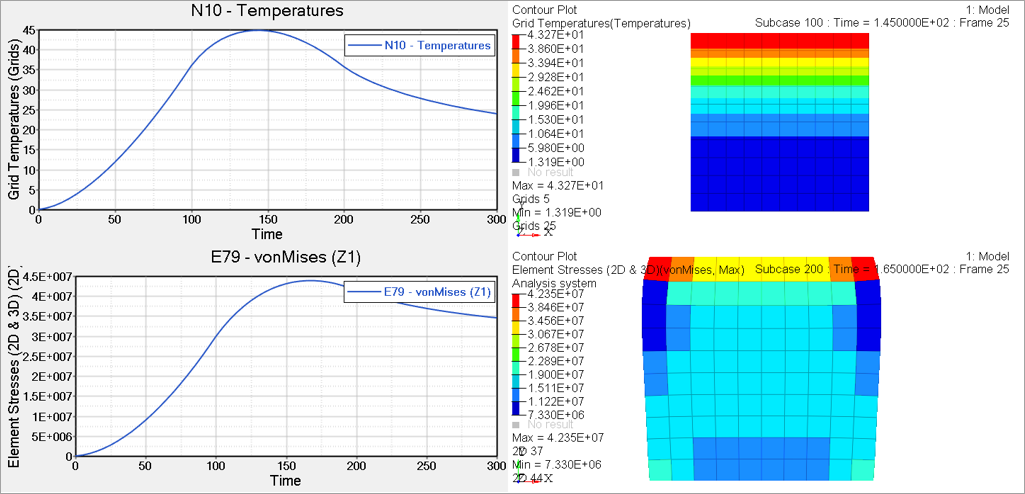One Step Transient Thermal Stress Analysis |

|

|

|

|
|
One Step Transient Thermal Stress Analysis |

|

|

|

|
Temperature history is available after a linear transient heat transfer analysis. One step transient thermal stress analysis is used to apply this temperature history (at multiple time steps) to a structural analysis. Linear transient Heat Transfer Analysis is run first, and the entire temperature history is now available for subsequent static analysis. The static analysis can be a linear or nonlinear subcase. For a linear OSTTS solution, after the transient heat transfer run, multiple linear static subcases are internally spawned (equal to the number of temperature loads from transient heat transfer) and the stress state is calculated for each “time-step” based on the applied temperature loads. For a nonlinear OSTTS run, multiple nonlinear static subcases are internally spawned (with CNTNLSUB). Therefore, the nonlinear state of each internally spawned subcase is applied as the initial state of the next subcase (in addition to temperature loads from transient heat transfer).
Linear and nonlinear OSTTS runs provide displacement and stress history for the duration of transient heat transfer.
A linear transient heat transfer subcase and a static subcase should be defined to perform a one-step transient thermal stress analysis. TEMPERATURE case control entries with the HTIME keyword can be used in the static subcase to select specific or all time steps to perform the stress analysis. Below is a sample input deck:
SUBCASE 100
TITLE = Transient thermal subcase
ANALYSIS = HEAT
THERMAL(sort1, punch)=ALL
FLUX=ALL
TSTEP = 100
IC = 20
DLOAD = 200
$
SUBCASE 200
TITLE = One step transient thermal stress subcase
SPC = 1
TEMP(LOAD,HTIME=ALL) = 100
DISPLACEMENT=ALL
STRESS=ALL
Temperature history and peak stress history from OSTTS are shown in Figure 1. The peak temperature is 43.27 degrees Celsius at 145 seconds, while the stress peak is 42.35 Mpa at 165 seconds. Note that the peak stress is not required to occur at the same time as the peak temperature or at the initial or final time step. This illustrates that OSTTS is useful in capturing the stress peak over the duration of the transient analysis.

Figure 1: Temperature history and peak stress of one step transient thermal stress analysis
Note
| 1. | OSTTS analysis is used to perform static analysis at all output time steps of Transient heat transfer analysis. Transient heat transfer analysis outputs temperature results for every time step by default. This can lead to high run times and possibly generate large result files. It is recommended to use the skip factor (NO# field) on the TSTEP entry to control the number of time steps at which temperature results are saved for output, such that OSTTS analysis can still capture the stress history without significant computational cost. |
| 2. | For Nonlinear OSTTS, the number of time steps at which output is generated should be further constrained using the skip factor. |
| 3. | DLOAD entry in Nonlinear Static Analysis is not supported for Nonlinear OSTTS. |